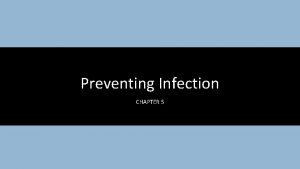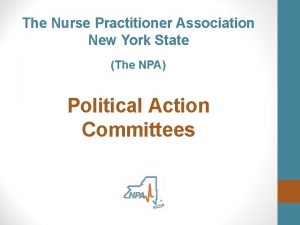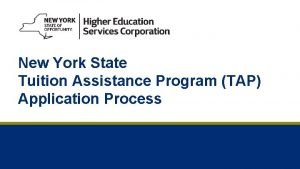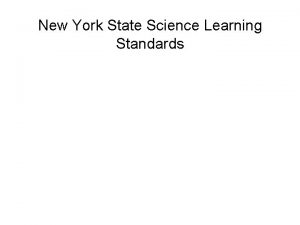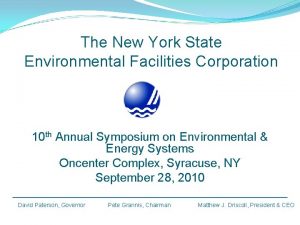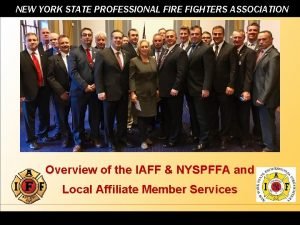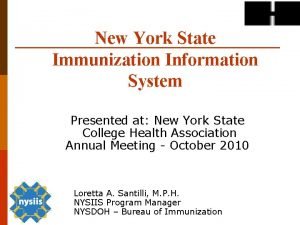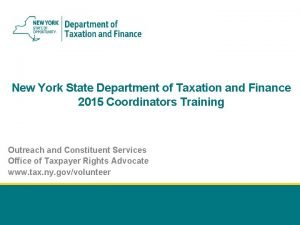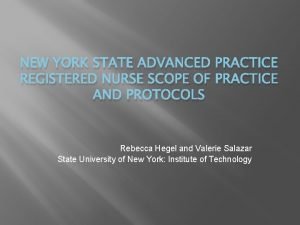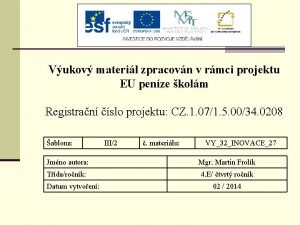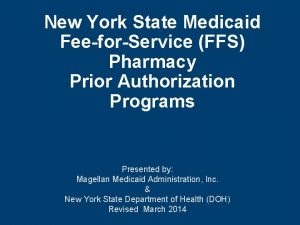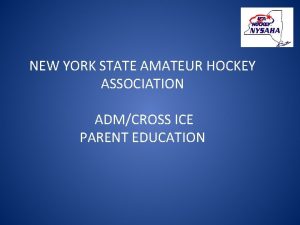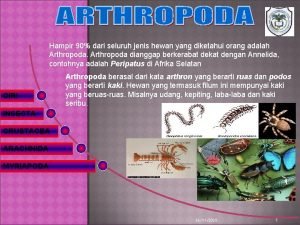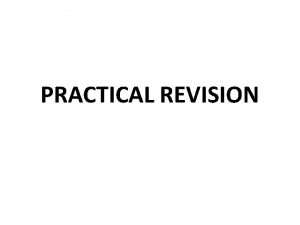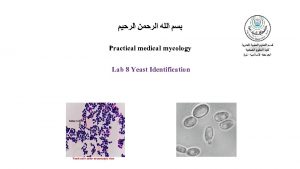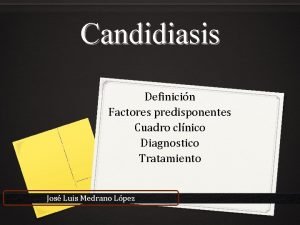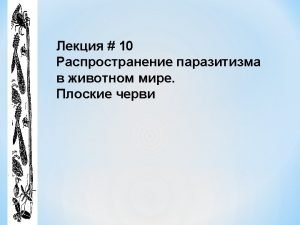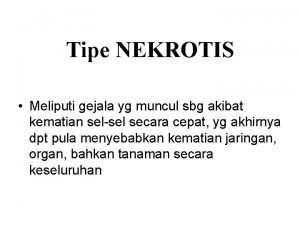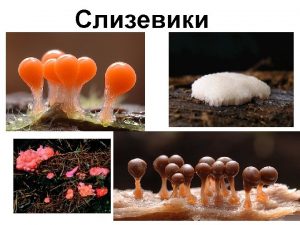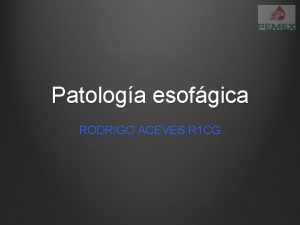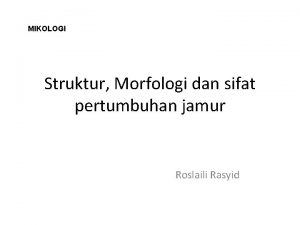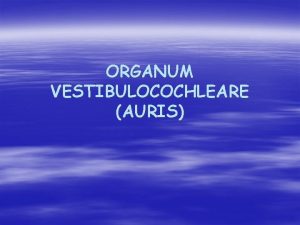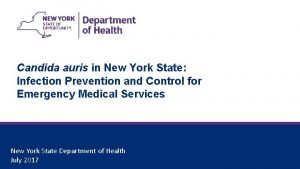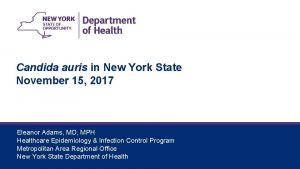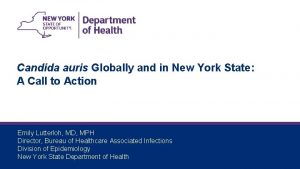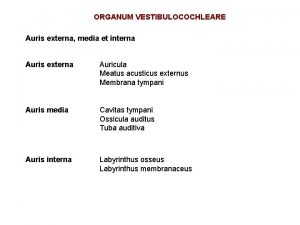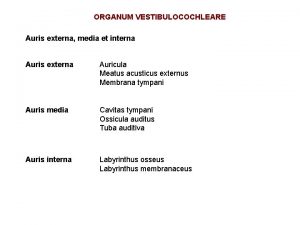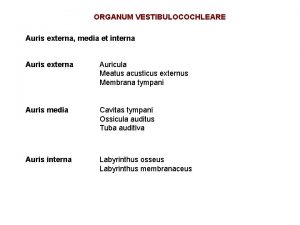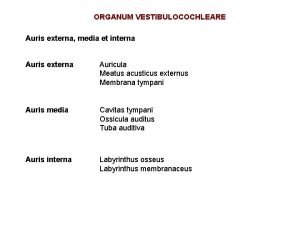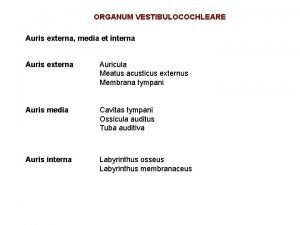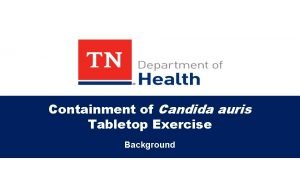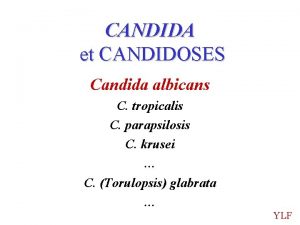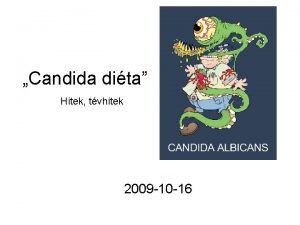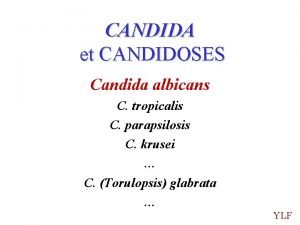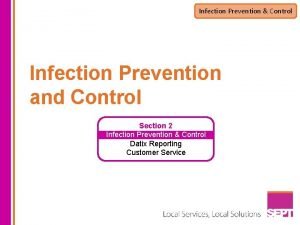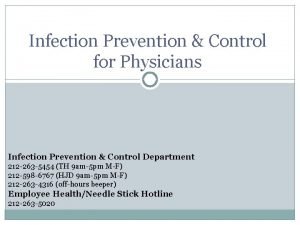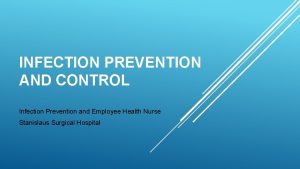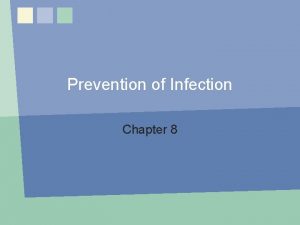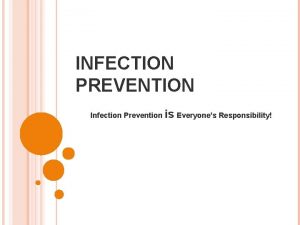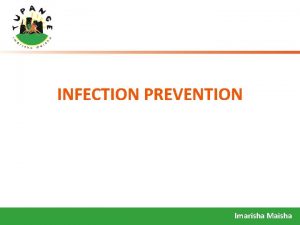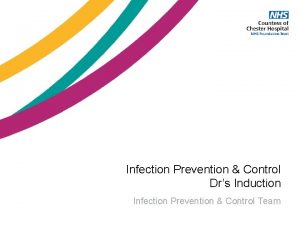Candida auris in New York State Infection Prevention








































- Slides: 40

Candida auris in New York State: Infection Prevention and Control for Home Healthcare and Hospice New York State Department of Health July 2017

November 23, 2020 2 Outline • Background – Candida auris – NYSDOH activities to help control Candida auris • Infection Prevention and Control – – Hand Hygiene Standard and Contact Precautions Cleaning and Disinfection Family and Caregiver Education 2

3 Background

November 23, 2020 4 What is Candida auris? (also called C. auris) • A fungus (yeast) that infects people who are sick for other reasons – Often infects blood – Can live on skin even after patients recover – Some people have it on their skin but don’t get sick (they are “colonized”) • Not the same as the yeast that causes diaper rash, “yeast infections” in women, and “thrush” in the mouth 4

November 23, 2020 5 Why Are We Worried? • It is hard for laboratories to identify • Anti-fungal medicines might not work against it • It spreads within hospitals, nursing homes, and other healthcare facilities • It can live for many weeks on surfaces and equipment 5

November 23, 2020 6 Rapid Emergence Since 2009 Japan 2009 South Korea 2010 2011 India 2012 2013 Pakistan S. Africa Venezuela Kenya Israel Kuwait United Kingdom 2014 2015 2016 Candida auris is now found in multiple states in the U. S. , including New York. 6

November 23, 2020 7 Cases in New York State 7

November 23, 2020 8 What Is New York State Doing? • Investigating reports of C. auris • Testing samples from patients and their surroundings at the New York State Public Health Laboratory, Wadsworth Center • Teaching healthcare staff about how to prevent and control C. auris infection and spread • Going to all hospitals and nursing homes in Brooklyn and Queens to help them prevent spread 8

9 Infection Prevention and Control

November 23, 2020 10 Why Is Infection Control Important for Candida auris? Stays on skin and other body parts for a long time Lives on surfaces for a long time Can be spread to others 10

November 23, 2020 11 Infection or Colonization Infection Colonization A person is sick from C. auris and needs treatment A person has C. auris on their body, but isn’t sick from it Both infected and colonized patients can shed C. auris onto nearby surfaces 11

November 23, 2020 12 Are Healthcare Workers At Risk? • C. auris does not typically cause infections in healthy people • Anyone can be colonized on the skin, but this doesn’t happen very often for healthcare workers https: //www. cdc. gov/fungal/diseases/candidiasis/qa-healthcare-workers. html Accessed 6/8/2017 12

November 23, 2020 13 How Does It Spread? 13

November 23, 2020 14 Protect Your Patients by: • Cleaning your hands • Using gowns and gloves correctly • Cleaning and disinfecting correctly 14

November 23, 2020 15 Hand Hygiene - Why? • Hands are the most common way pathogens are spread in healthcare • C. auris can live on surfaces and objects – Can be picked up on hands and spread • Gloves are not a substitute for hand hygiene Always follow your agency-specific policy! Source: https: //www. cdc. gov/handhygiene/providers/guideline. html (including image) 15

November 23, 2020 16 Hand Hygiene – Before • • • Before contact with patient Before reaching into the homecare bag Before performing an aseptic task Before leaving the patient’s home Before eating Always follow your agency-specific policy! Source: https: //www. cdc. gov/handhygiene/providers/guideline. html 16

November 23, 2020 17 Hand Hygiene – After • After contact with patient • After contact with body fluids or visibly contaminated surfaces • After contact with objects/surfaces in patient’s environment • After removing PPE (e. g. , gloves, gowns) • After using a restroom Always follow your agency-specific policy! Source: https: //www. cdc. gov/handhygiene/providers/guideline. html 17

November 23, 2020 18 Hand Hygiene - Wash or Sanitize? Wash with soap and water when: – Hands are visibly dirty – Caring for patients during outbreaks of infectious diarrhea, like C. difficile or norovirus – Before eating – After using the restroom In most other cases, use alcohol-based hand sanitizer Source: Shutterstock Always follow your agency-specific policy! Source: https: //www. cdc. gov/handhygiene/providers/guideline. html 18

November 23, 2020 19 Hand Sanitizing – How? Alcohol-based hand sanitizer • Put product on hands • Cover all parts of the hand nails with the sanitizer • Rub hands together until dry Source: Shutterstock Always follow your agency-specific policy! Source: https: //www. cdc. gov/handhygiene/providers/guideline. html 19

November 23, 2020 20 Hand Washing – How? Always follow your agency-specific policy! Image: http: //www. health. state. mn. us/handhygiene/wash/dontforget. html 20

November 23, 2020 21 Hand Hygiene – Fingernails, too • Keep fingernails short and clean • Best to avoid artificial nails – Gels, wraps, extensions, nail jewelry, etc. – Bacteria, viruses, and fungi can stick to artificial nails – Some studies found more germs on artificial fingernail surfaces, both before and after hand-washing Always follow your agency-specific policy! Source: https: //www. cdc. gov/mmwr/PDF/rr/rr 5116. pdf 21

November 23, 2020 22 Standard Precautions Every patient, every day Hand hygiene Personal protective equipment based on your task Safe injection practices Respiratory hygiene/cough etiquette Always follow your agency-specific policy! Source: https: //www. cdc. gov/hicpac/pdf/isolation/Isolation 2007. pdf 22

November 23, 2020 23 Personal Protective Equipment (PPE) Always follow your agency-specific policy! 23

November 23, 2020 24 Wearing Gloves During Patient Care • Gloves are not a substitute for hand hygiene • Wear gloves when cleaning surfaces in the environment or medical equipment • Remove gloves and perform hand hygiene – Moving from a contaminated to clean area of the same patient – After completing care of your patient Always follow your agency-specific policy! Slide adapted from: https: //www. cdc. gov/dialysis/clinician/ce/infection-prevent-outpatient-hemo. html; Infection Prevention in Dialysis Settings Continuing Education Module 24

November 23, 2020 25 Contact Precautions • Used to stop the spread of C. auris • Gloves and gowns put a barrier between you and the patient and surfaces around the patient • If you are unsure, ask! Always follow your agency-specific policy! Source: https: //www. cdc. gov/hicpac/pdf/isolation/Isolation 2007. pdf 25

November 23, 2020 26 Personal Protective Equipment (PPE) Pop Quiz! • Where do I get gloves, gowns, and eye protection or face masks? – If needed, where do I find more? • When do I need to put PPE on? • Where should I take PPE off? Always follow your agency-specific policy! Source: Shutterstock 26

November 23, 2020 27 Medical Equipment and Devices • Reusable medical equipment and devices should remain in the home ‒ Includes stethoscopes and blood pressure cuffs • If not possible, clean and disinfect before removing items from patient’s home 27

November 23, 2020 28 Scheduling Considerations • Consider scheduling home visits for a patient with C. auris as the last visit of the day • Otherwise, schedule visits to avoid seeing a patient with C. auris before patients at highest risk of infection • Discuss scheduling strategies with your nursing or medical director Source: Can Stock Photo 28

November 23, 2020 29 Home Health Care and Hospice Personnel • Notify receiving providers and/or healthcare facilities if a patient has any history of C. auris colonization or infection before or immediately at the time of transfer Source: Can Stock Photo 29

November 23, 2020 30 Cleaning and Disinfection – How? • Use the correct product! – For C. auris, use the same product you use for Clostridium difficile • Know how to use your products! – Does it clean and disinfect at the same time? – How long is the contact time (aka dwell time)? – Do I need to clean more than once to get the correct contact time? – Does it need to dry itself or can I wipe it off? Always follow your agency-specific policy! 30

November 23, 2020 31 Cleaning and Disinfection – What? • • Know who’s responsible for cleaning the patient’s immediate environment Know which product to use and when Which reusable medical equipment is dedicated to a single patient with an MDRO and why? When and how do I clean equipment that I’m taking out of the home? Always follow your agency-specific policy! Source: https: //www. cdc. gov/hicpac/pdf/isolation/Isolation 2007. pdf 31

November 23, 2020 32 Cleaning and Disinfection Pop Quiz! • Which cleaning product and disinfectant do we use for C. auris? • How long is the contact time for our C. auris product? • Who is responsible for cleaning specific items • Example: Oxygen concentrators (when in use) • How often? • Which cleaning product? • Example: Patient’s commode and shower chair • Which cleaning product? Always follow your agency-specific policy! 32

November 23, 2020 33 Patient and Family Education • All household members and visitors should practice good hand hygiene • If family or friends provide extensive care such as changing the dressing on an infected wound, consider wearing disposable gloves while providing this level of care • Clean the patient’s environment on a routine basis and when soiled Source: Can Stock Photo 33

November 23, 2020 34 Patient and Family Education • Linens, clothing, and towels should be dedicated to the patient – Launder towels after each use • Wash and dry linens when they are soiled and on a routine basis – Linens and towels used by the patient do not need to be washed separately • Dishes and flatware can be washed as usual either in a dishwasher or using hot, soapy water 34

November 23, 2020 35 Summary • Infection prevention and control activities are shared responsibilities in healthcare • Help prevent C. auris spread in healthcare settings by: – Performing hand hygiene – Using Standard and Contact Precautions – Cleaning and disinfecting surfaces and equipment in healthcare settings 35

November 23, 2020 36 References 1. 2. 3. 4. 5. 6. 7. 8. 9. 10. 11. 12. 13. 14. 15. 16. 17. 18. 19. 20. 21. Borman AM, Szekely A, Johnson EM. Comparative pathogenicity of United Kingdom isolates of the emerging pathogen Candida auris and other key pathogenic Candida species. m. Sphere. 2016; 1: e 00189– 16. Calvo B, Melo ASA, Perozo-Mena A, et al. First report of Candida auris in America: clinical and microbiological aspects of 18 episodes of candidemia. J Infect. 2016; 73: 369– 74. Chakrabarti A, Sood P, Rudramurthy SM, et al. Incidence, characteristics and outcome of ICU-acquired candidemia in India. Intensive Care Med. 2015; 41: 285– 95. Chowdhary A, Kumar VA, Sharma C, et al. Multidrug-resistant endemic clonal strain of Candida auris in India. Eur J Clin Microbiol Infect Dis. 2014; 33: 919– 26. Chowdhary A, Sharma C, Duggal S, et al. New clonal strain of Candida auris, Delhi, India. Emerg Infect Dis. 2013; 19: 1670– 3. Chowdhary A, Voss A, Meis JF. Multidrug-resistant Candida auris: ‘new kid on the block’ in hospital-associated infections? J Hosp Infect. 2016; 94: 209– 12. Emara M, Ahmad S, Khan Z, et al. Candida auris candidemia in Kuwait, 2014. Emerg Infect Dis. 2015; 21: 1091– 2. Kathuria S, Singh PK, Sharma C, et al. Multidrug-resistant Candida auris misidentified as Candida haemulonii : characterization by matrix-assisted laser desorption ionization-time of flight mass spectrometry and DNA sequencing and its antifungal susceptibility profile variability by Vitek 2, CLSI broth microdilution, and Etest method. J Clin Microbiol. 2015; 53: 1823– 30. Kim M-N, Shin JH, Sung H, et al. Candida haemulonii and closely related species at 5 university hospitals in Korea: identification, antifungal susceptibility, and clinical features. Clin Infect Dis. 2009; 48: e 57– 61. Lee WG, Shin JH, Uh Y, et al. First three reported cases of nosocomial fungemia caused by Candida auris. J Clin Microbiol. 2011; 49: 3139– 42. Lockhart SR, Etienne KA, Vallabhaneni S, et al. Simultaneous emergence of multidrug resistant Candida auris on three continents confirmed by whole genome sequencing and epidemiological analyses. Clin Infect Dis. Advance access, published October 20, 2016, accessed December 15, 2016. Magobo RE, Corcoran C, Seetharam S, et al. Candida auris-associated candidemia, South Africa. Emerg Infect Dis. 2014; 20: 1250– 1. Oh BJ, Shin JH, Kim M-N, et al. Biofilm formation and genotyping of Candida haemulonii , Candida pseudohaemulonii , and a proposed new species (Candida auris) isolates from Korea. Med Mycol. 2011; 49: 98– 102. Okinda N, Kagotho E, Castanheira M , et al. Candidemia at a referral hospital in sub-Saharan Africa: emergence of Candida auris as a major pathogen. European Congress of Clinical Microbiology and Infectious Diseases. Barcelona, 2014. Poster presentation. Sarma S, Kumar N, Sharma S, et al. Candidemia caused by amphotericin B and fluconazole resistant Candida auris. Indian J Microbiol. 2013; 31: 90– 1. Satoh K, Makimura K, Hasumi Y, et al. Candida auris sp. nov. , a novel ascomycetous yeast isolated from the external ear canal of an inpatient in a Japanese hospital. Microbiol Immunol. 2009; 53: 41– 4. Schelenz S, Hagan F, Rhodes JL, et al. First hospital outbreak of the globally emerging Candida auris in a European hospital. Antimicrob Resist Infect Control. 2016; 5: e. Collection. Siegel JD, Rhinehart E, Jackson M, Chiarello L, and the Healthcare Infection Control Practices Advisory Committee, 2007 Guideline for Isolation Precautions: Preventing Transmission of Infectious Agents in Healthcare Settings. https: //www. cdc. gov/hicpac/pdf/isolation 2007. pdf Images from the Centers for Disease Control and Prevention, Public Health Image Library. https: //phil. cdc. gov/phil/quicksearch. asp Centers for Disease Control and Prevention Guideline for Hand Hygiene in Health-Care Settings: Recommendations of the Healthcare Infection Control Practices Advisory Committee and the HICPAC/SHEA/APIC/IDSA Hand Hygiene Task Force. MMWR 2002; 51 (No RR-16). https: //www. cdc. gov/mmwr/PDF/rr/rr 5116. pdf Centers for Disease Control and Prevention Infection Recommendations for Infection Control for Candida auris. Available at: https: //www. cdc. gov/fungal/diseases/candidiasis/c-auris-infection-control. html. Retrieved 7/25/17 36

November 23, 2020 37 Additional Material Additional material is included here to assist presenters. These materials include a pre/post-test and vignettes from observations made by the NYSDOH during site visits. 37

November 23, 2020 38 Pre-test and Post-test • • What is Candida auris? List two reasons why Candida auris is of concern State the difference between colonization and infection with Candida auris yeast What type of transmission-based precautions are needed to care for a patient with Candida auris? What cleaning product should be used for Candida auris? Identify the times when hand hygiene must be performed. Identify how your agency communicates when to use Contact or Droplet precautions. 38

November 23, 2020 39 Infection Control Breach Observations • Environmental Cleaning – Ventilator screens have been observed to either not be cleaned while in routine use or not cleaned with a sporicidal agent. NYSDOH has identified C. auris from ventilators after the equipment had reportedly been terminally cleaned. – Shared equipment such as mechanical patient lifts are not cleaned with sporicidal agent. – Cleaning and disinfection was performed using a spray bottle. The cleaning agent was sprayed on and then immediately wiped off, so did not stay on the surface for the appropriate contact time. – Cleaning products that are not intended or registered for use in a healthcare environment have been observed in healthcare facilities. – The products in use are not effective against the organisms in the environment. For example, cleaning products available for cleaning and disinfection when a patient has C. difficile or C. auris were not EPA registered as effective against spores. 39

November 23, 2020 40 Infection Control Breach Observations • Contact Precautions and PPE – Multiple types of healthcare workers, including frontline staff, nursing leadership (Director of Nursing), and physicians have been observed entering rooms without PPE and without having performed hand hygiene. – PPE is not worn correctly. Observations include healthcare workers with gowns untied and hanging off the neck. Inappropriate gowns for healthcare have been observed, including apron-type gowns with no sleeves to protect arms. – PPE has been unavailable to staff for use with Standard and Contact Precautions. For example, PPE was stored in a locked cabinet down the hall and facility could not locate the key. PPE needed to care for a resident on Contact Precautions has been observed stored in a clean linen cart down the hall. – Staff interview identified that staff did not understand that PPE is still needed when Contact Precautions are in place after a room had just been cleaned. – Color-coded signs were in use to indicate Transmission-based Precautions, including Contact Precautions, but frontline staff couldn’t recall what the colors meant. 40
 Primary prevention secondary prevention tertiary prevention
Primary prevention secondary prevention tertiary prevention Puncture resistant container
Puncture resistant container Chapter 19 disease transmission and infection prevention
Chapter 19 disease transmission and infection prevention Chapter 19 disease transmission and infection prevention
Chapter 19 disease transmission and infection prevention Chapter 16 infection prevention and control
Chapter 16 infection prevention and control Define infection prevention chapter 5
Define infection prevention chapter 5 New york state nurse practitioner association
New york state nurse practitioner association Ny state tap
Ny state tap New york state teacher certification exams
New york state teacher certification exams New york state standards science
New york state standards science 2018 nys math test
2018 nys math test New york mesonet
New york mesonet New york state vegetable
New york state vegetable New york state environmental facilities corporation
New york state environmental facilities corporation New york state professional firefighters association
New york state professional firefighters association What is nysiis
What is nysiis New york state association of transportation engineers
New york state association of transportation engineers Nysid catalog
Nysid catalog Nys division of criminal justice services
Nys division of criminal justice services New york state reliability council
New york state reliability council How many roundabouts in new york
How many roundabouts in new york 414hsub
414hsub Nys rn scope of practice
Nys rn scope of practice New york state fish
New york state fish New york state nickname
New york state nickname New york state medicaid prior authorization
New york state medicaid prior authorization New york state amateur hockey association
New york state amateur hockey association New york state county highway superintendents association
New york state county highway superintendents association New york, new jersey, pennsylvania, and delaware
New york, new jersey, pennsylvania, and delaware Orchard 14 marquee cinema
Orchard 14 marquee cinema Articles of confederation characteristics
Articles of confederation characteristics Leanne keene french ambassador arrives from paris
Leanne keene french ambassador arrives from paris Sefalotoraks artinya
Sefalotoraks artinya Candida albicans germ tube test
Candida albicans germ tube test Candida albicans germ tube test
Candida albicans germ tube test Vagina con candida albicans
Vagina con candida albicans Bdelloura
Bdelloura Albugo candida
Albugo candida Trichiales
Trichiales Clasificación kodsi candida
Clasificación kodsi candida Tinea versicolor merupakan jamur
Tinea versicolor merupakan jamur





